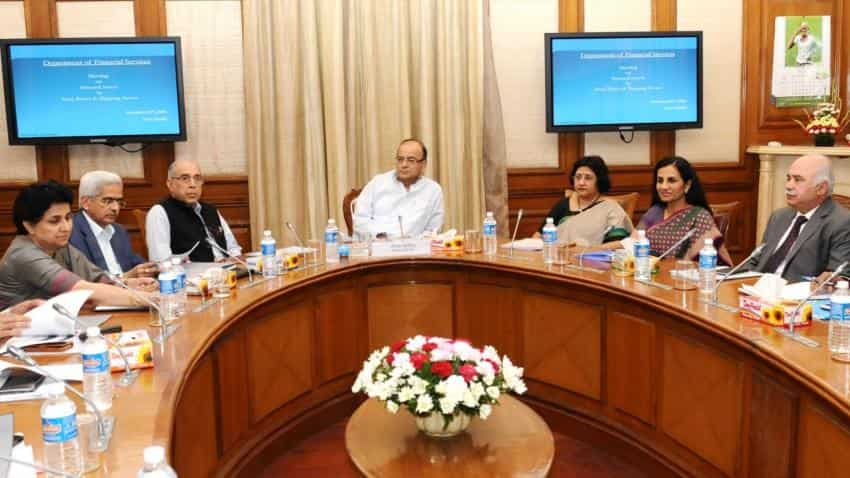These two companies stand to gain immensely if India goes ahead with steel sector bankruptcies
RBI said, "The Internal Advisory Committee (IAC) recommended for IBC reference all accounts with fund and non-fund based outstanding amount greater than Rs 5000 crore, with 60% or more classified as non-performing by banks as of March 31, 2016. The IAC noted that under the recommended criterion, 12 accounts totaling about 25% of the current gross NPAs of the banking system would qualify for immediate reference under IBC."

KEY HIGLIGHTS:
- Steel sector accounts for five out of 12 companies referred to the IBC
- Consolidation in steel sector possible if these companies go for insolvency
- Tata Steel and JSW Steel are likely gainers
On June 13, 2017, the Reserve Bank of India (RBI) has asked banks to file 12 accounts under the Insolvency and Bankruptcy Code (IBC).
RBI said, "The Internal Advisory Committee (IAC) recommended for IBC reference all accounts with fund and non-fund based outstanding amount greater than Rs 5000 crore, with 60% or more classified as non-performing by banks as of March 31, 2016. The IAC noted that under the recommended criterion, 12 accounts totaling about 25% of the current gross NPAs of the banking system would qualify for immediate reference under IBC."
ALSO READ: Steel sector accounts for biggest chunk of NPAs: FM Arun Jaitley
It further said that based on the recommendations of the IAC, RBI will accordingly be issuing directions to banks to file for insolvency proceedings under the IBC in respect of the identified accounts. "Such cases will be accorded priority by the National Company Law Tribunal (NCLT)," the central bank added.
Interestingly, out of these 12 companies that are now referred to the IBC, five are steel companies.
These five steel companies, at 22 million tonne, constitute 17% of India's total steel production capacity and 12% of the total output as of last year.
According to World Steel Association, India currently is world's third largest steel producer at 95.6 million tonne of steel production 2016.
China and Japan are at the first two spots with 808.4 million tonne and 104.8 million tonne, respectively with the US in fourth spot at 78.5 million tonne.
The US, despite being behind India in steel production, has higher steel consumption per capita, at 282.7 tonne as against India's 63 tonne, World Steel Association further said.
ALSO READ: Top 20 bad loans account for Rs 1.5 lakh crore, reveals FM Arun Jaitley
This is important to note as it focusses on the tremendous opportunity that steelmakers in India have been chasing, which partially led to the overleveraging that is now causing the sectors this massive trouble of unpaid bank loans.
Global steelmakers like ArcelorMittal and POSCO, who signed agreements with state governments in India is as far back as 2005-2006 are yet to begin construction of their steel plants which domestic steel players have been growing largely by acquisitions.
The steel ministry in India had set a target of 2012 to reach 120 million tonne of steel production. At nearly 96 million tonne of steel production last year, India is still far from reaching that target.
The Top Five
The top five companies referred to the IBC are: Bhushan Steel, Bhushan Power and Steel Ltd, Electrosteel Castings, Monnet Ispat and Essar Steel.
Together, these five companies handle 22 million tonne of steel production, or 17% of India's total steel capacity.
These five companies referred to th INBC have debt ranging from $1200 per tonne to $2000 per tonne. Banks, in order to get rid of these companies from their books, will have to offer steep haircuts. The four analysts at Credit Suisse said, "Given high debt levels ($1,200-2,000 per tonne), banks may have to take 56% haircut, to get to a more palatable EV of $700 per tonne for potential suitors. Note that JSW’s current brownfield expansion cost is pegged at just $460 per tonne. If MIP-like tariffs remain in place, we estimate these assets cansustainably generate an EBITDA of $70-100 per tonne."
What's In It For Banks?
The steel sector accounts for 20-30% of NPAs and the five companies are 50-80% of banks’ steel sector Non-Performing Assets (NPA). "A resolution in these five can thus, result in 100-200 basis points reduction in Gross NPAs. However, this will need Rs 35,000 crore of additional provisions," Credit Suisse said. Only ICICI may not need further dilution.
ALSO READ: Here's how banks can save themselves from NPA stress
The bankruptcy process may be long drawn although the IBC provides only 180 days (extendable to 270) for the creditors to agree upon a resolution plan failing which the company moves to liquidation. Historically, in large cases banks have preferred to retain existing management and restructure debt. However, with heightened focus on resolution plans and RBI's likely provisioning policies, an ownership change now appears to be more likely.
Who Stands to Gain?
Flats steelmakers like Tata Steel and JSW Steel stand to gain from industry consolidation, Credit Suisse said.
Ravi Shankar, Ashish Gupta, Neelkanth Misra, Prateek Singh and Kush Shah of Credit Suisse, in a report dated June 22, 2017 said, "Tata and JSW are already operating at 90%+ utilisation levels and planning expansions. Acquisition of these capacities can raise the share of Major Four to 60% of domestic industry capacity. In the flats segment, the Major 4 could reach an oligopolistic 90%+ share."
Get Latest Business News, Stock Market Updates and Videos; Check your tax outgo through Income Tax Calculator and save money through our Personal Finance coverage. Check Business Breaking News Live on Zee Business Twitter and Facebook. Subscribe on YouTube.
09:41 AM IST














 Markets look tired but expiry could change things
Markets look tired but expiry could change things NPA rate under ECLGS at 4.8 per cent in March 2022: Report
NPA rate under ECLGS at 4.8 per cent in March 2022: Report NARCL begins process of buying bank NPAs; gives binding offer to IOB on Rainbow Paper
NARCL begins process of buying bank NPAs; gives binding offer to IOB on Rainbow Paper NCLT poses tough questions to lenders and Siva Industries
NCLT poses tough questions to lenders and Siva Industries  Siva Industries case: The BIG GAME of Bank, NPA and Settlement! WHY banks agreed to settle huge loan of Rs 4863 crore at just Rs 323 cr? BIG QUESTIONS RAISED!
Siva Industries case: The BIG GAME of Bank, NPA and Settlement! WHY banks agreed to settle huge loan of Rs 4863 crore at just Rs 323 cr? BIG QUESTIONS RAISED!